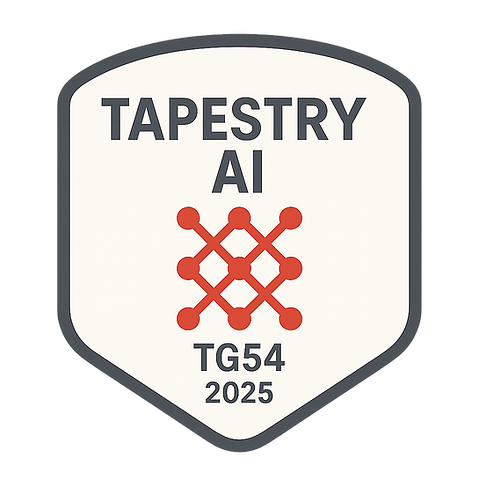
Cybersecurity Architecture & Engineering AI Framework (CAE+AI)
Project Tapestry applies field-proven engineering and architecture practices to every layer of your AI stack—delivering security that’s designed-in, not bolted-on.
Why Engineering Discipline Matters for AI Security
Overview:
AI is evolving faster than traditional compliance frameworks can keep up. Project Tapestry leverages proven cybersecurity architecture and engineering disciplines to rigorously apply them to AI. It’s not just about adding AI to your security—it's about ensuring your AI is secure by design.
Why the Name “Tapestry”?
The Task Group chose the word 'Tapestry' because today’s AI security challenge is less a single fabric and more a weave of many distinct threads—identity, data integrity, threat resilience, governance, and engineering discipline. A tapestry is only strong when every thread is interlocked; likewise, our framework interlaces proven cybersecurity architecture practices with emerging AI controls so that no one strand can be pulled apart. The name reminds us that security-by-design is the art of weaving disparate controls into one resilient whole—visible, inspectable, and engineered for strength.
The Tapestry Framework Vision
Project Tapestry focuses on three critical pillars essential for engineering robust AI security:
-
AI Identity and Trust Fabric – Secure connectivity and verified access using Zero Trust principles, service mesh architectures, and rigorous API authentication.
-
AI Data and Model Integrity Weave – Comprehensive, lifecycle-long protection of AI data and models, utilizing encryption, model provenance, secure MLOps, and robust supply-chain security.
-
AI Threat Resilience Mesh – Adaptive threat defenses and real-time observability designed to rapidly detect and neutralize threats, ensuring continuous operational security and integrity.
Measured Results—Because Engineering is Quantifiable
Test 1: User Acceptance Testing (UAT) & Cybersecurity Team Findings
Internal cybersecurity teams tested Project Tapestry rigorously in simulated real-world scenarios. Key outcomes included:
-
40% faster incident response times
-
33% reduction in audit preparation efforts
-
Clearly defined roles, increased observability, and explicit accountability via micro-RACI role definitions
Challenges such as vendor onboarding and initial training have been identified for refinement in the following version updates.
Note: Due to NDAs, we are not permitted to mention or disclose specific company names involved in the testing and evaluation processes.
Test 2: Technical Research Center (TRC) Comparative Analysis
ISAUnited’s Technical Research Center (TRC) led, project-managed, and collaborated with an independent cybersecurity team to conduct the "AI Security Framework Comparative Analysis – ISAUnited vs. Google vs. NIST," evaluating multiple frameworks.
Key outcomes from the collaborative testing include:
-
Overall Score: 90%
-
Project Tapestry was rated significantly higher in technical precision, operational effectiveness, and ease of practical implementation compared to Google’s SAIF and NIST’s AI RMF.
The collaborative assessment recommends adopting Project Tapestry as the primary technical framework, complemented by governance strategies from NIST and continuous improvement methodologies from Google.
Tapestry Moving from Project to Production
Project Tapestry is rapidly approaching its official launch. ISAUnited.org is excited to announce that upon going live, Project Tapestry will be available for everyone to download—completely FREE. Our goal is to enable every organization, regardless of size or sector, to build AI environments securely from the ground up.
Next Steps
ISAUnited is committed to the ongoing refinement of Project Tapestry:
-
Regular updates addressing evolving threats and technology advancements
-
Continuous education through professional training programs
-
Expansion of vendor assessment tools and enhanced customization guidelines
Project Tapestry is not just another security framework—it’s an engineering blueprint for building resilient, secure, and trustworthy AI environments, empowering your business to innovate and drive growth confidently.
Stay Tuned
Your AI systems deserve more than patches and policies—they need principled design, engineered protection, and a roadmap that scales with innovation.
